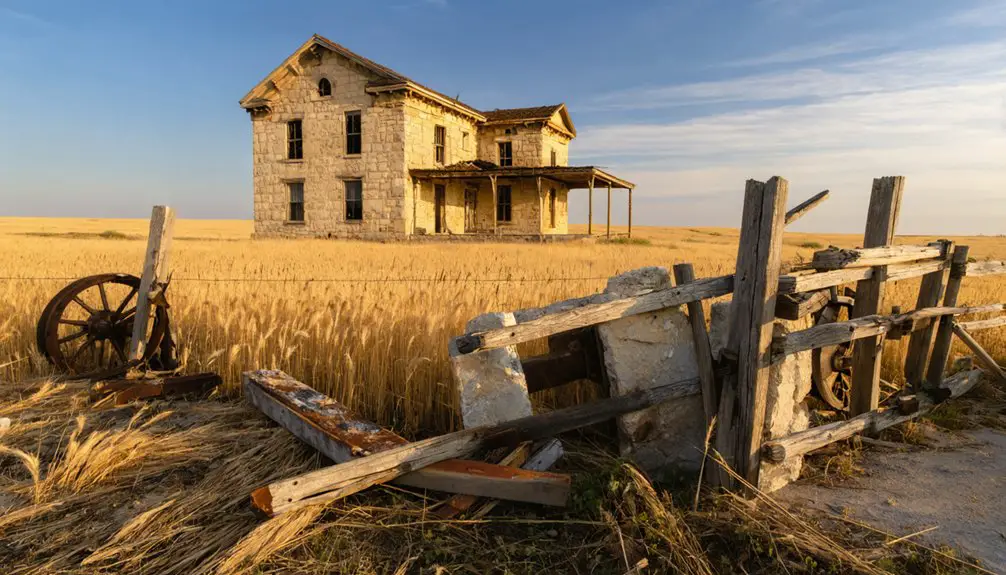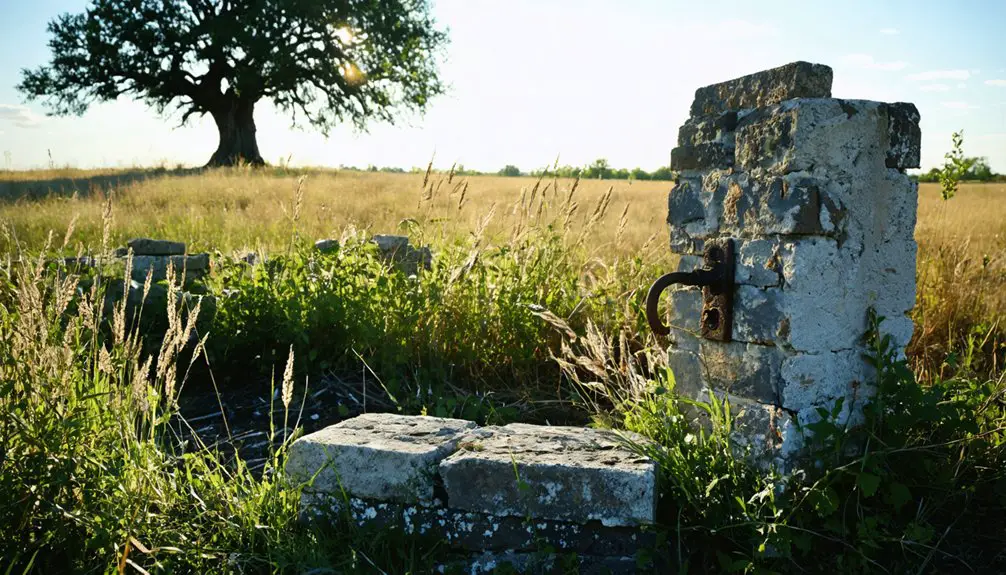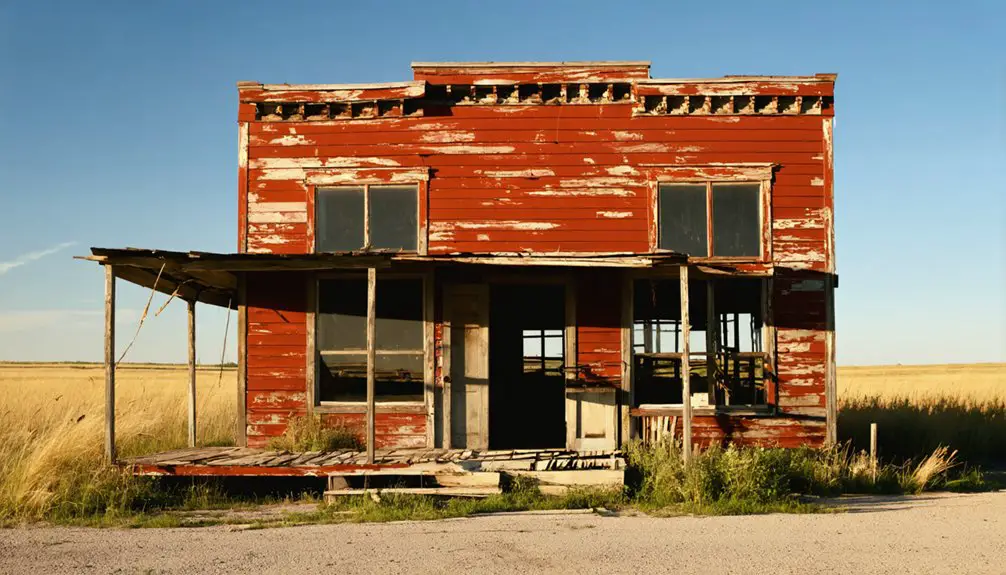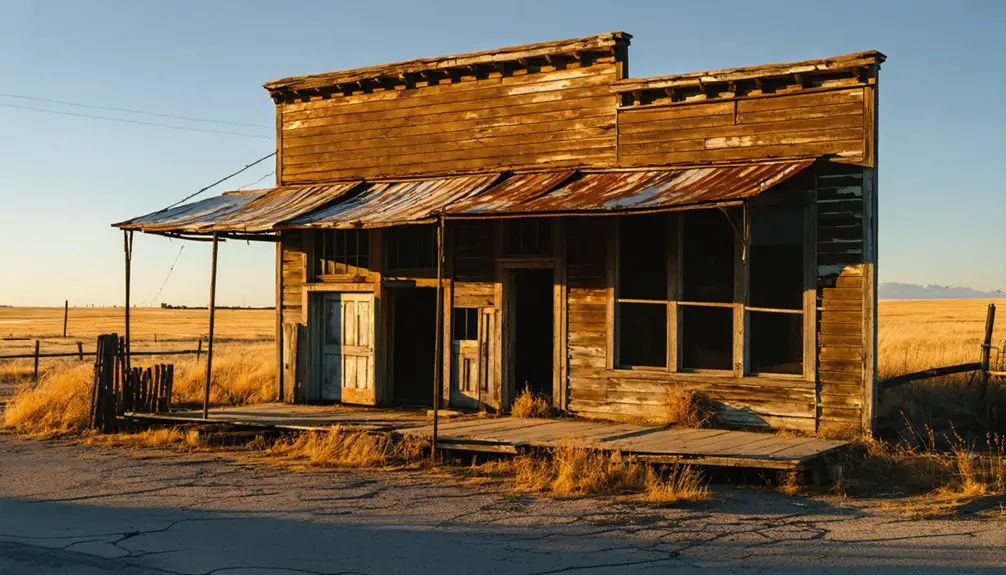You’ll find Hyatt’s ghost town roots in its 1856 founding as a Free State settlement along Cedar Creek, Kansas. Anti-slavery activists Thaddeus Hyatt and W.F.M. Arny led 80 militiamen to establish this frontier outpost during “Bleeding Kansas.” The town developed sawmills and gristmills, but faced harsh conditions and border conflicts. Though the settlement’s physical traces have largely vanished, its story as a Free State stronghold offers fascinating insights into Kansas’ turbulent territorial period.
Key Takeaways
- Hyatt was established in 1856 by Free State settlers from Lawrence, Kansas, but failed to sustain itself as a permanent settlement.
- The town’s remote location, harsh frontier conditions, and ongoing political violence during “Bleeding Kansas” contributed to its eventual abandonment.
- Despite initial industrial progress with sawmills and gristmills, lack of railroad access limited commercial growth and economic sustainability.
- Archaeological evidence reveals layers of settlement history through artifacts, showing the brief but significant presence of early Kansas pioneers.
- The site has been reclaimed by nature, with only agricultural terracing and scattered remains marking where this Free State community once stood.
The Founding of a Free State Settlement

In December 1856, amid the turbulent Bleeding Kansas period, a determined group of Free State settlers from Lawrence established the colony of Hyatt in Anderson County.
Led by Thaddeus Hyatt and W.F.M. Arny, the settlement included about 80 men, most of whom had just been discharged from the Free State Militia.
Under the leadership of Hyatt and Arny, 80 former Free State militiamen formed the core of this ambitious settlement.
You’ll find their Settlement Goals were clear – to strengthen the Free State presence in the region while building a thriving community.
The settlers, including Captain James A. Harvey and others who’d been pro-slavery prisoners in Missouri, set up camp in Washington Township on December 18.
They staked their claims along Cedar and South Pottawatomie Creeks, living in tents through their first winter while preparing timber for essential buildings.
The Town Company formed in February 1857 with W.F.M. Arny serving as president.
The colony represented a bold statement against pro-slavery influence in Kansas Territory.
The settlement quickly developed with the construction of a hotel and store during the harsh winter months.
Life on Cedar Creek’s Frontier
While establishing a foothold along Cedar Creek, settlers faced the harsh realities of frontier life that demanded constant vigilance and self-sufficiency.
You’d find them building log cabins near water sources, farming their own food, and hunting to survive. The frontier challenges weren’t just environmental – political tensions from the border wars and raids during the Civil War period tested their social resilience. Fort Drinkwater became a crucial refuge for settlers during periods of Indian unrest.
Local grocery stores and mills gradually emerged by the late 1850s, providing essential services to the growing community. You’d need to stay alert for fires, which posed a constant threat to wooden structures. Santa Fe Trail travelers passing through provided opportunities for trade and news from other regions.
Many settlers aligned themselves with Free-State advocates, though some maintained neutral stances during times of conflict. Native American interactions ranged from cooperative trade to territorial disputes, adding another layer of complexity to daily survival.
From Military Camp to Township

As Free State Militia members set up their initial encampment in fall 1856, Hyatt’s transformation from military outpost to organized township began taking shape.
You’ll find that 87 former pro-slavery prisoners, now Free State fighters, joined Thaddeus Hyatt and William F.M. Arny to establish their settlement along Cedar Creek.
The military origins quickly evolved through strategic settlement planning. During that first harsh winter, you’d have seen the determined settlers cutting timber and constructing essential buildings – a hotel, store, and blacksmith shop. Just as the Hyatt Regency Hotel would face tragedy 125 years later in Kansas City, these early settlers too faced immense challenges in establishing their foothold. The resilient spirit of Kansas builders would be tested again when 114 lives were lost in the devastating walkway collapse of 1981.
Building a Pioneer Community
You’ll find that Hyattville’s initial infrastructure centered around the strategic placement near Pottawattamie Creek, where the 84 pioneers first established temporary shelters.
The settlement’s early housing consisted of basic structures built by the militiamen-turned-settlers using local materials and following common frontier construction methods of the 1850s. The engineers later faced significant scrutiny when their structural designs failed, leading to devastating consequences.
Under Thaddeus Hyatt’s direction, the pioneers focused on developing essential community facilities while managing limited resources from National Kansas Committee funding. The community struggled to maintain operations when fund depletion affected settlement activities by mid-1857.
Early Infrastructure Development
During the early development of Hyatt, Kansas, ambitious infrastructure plans centered on an innovative multi-story atrium complex featuring suspended walkways and glass elevators.
You’ll find that the original design aimed to create a striking visual impact while maintaining functionality through an integrated system of elevated passages connecting the hotel wings.
The infrastructure challenges began when contractors made critical mid-construction changes, switching from single continuous support rods to separate sets for each walkway.
This cost-cutting measure doubled the stress on fourth-floor connections and compromised structural integrity.
Construction supervisors failed to properly inspect welding deficiencies and assembly problems, while time pressures led to rushed work.
Despite the community’s resilience in responding to the eventual catastrophe, these oversights resulted in a devastating collapse that claimed 114 lives and left over 216 injured.
The fast-track construction methods popular during the late 1970s economic crisis prioritized speed over safety in large building projects.
A deep metallic snap signaled the imminent failure of the walkway system just moments before the catastrophic collapse.
Pioneer Housing Solutions
When pioneers first settled in Hyatt, Kansas, they developed pragmatic housing solutions using locally available materials like sod, timber, and limestone.
You’d find sod houses, known as “soddies,” were common due to scarce timber supplies. These homes offered excellent insulation against harsh Kansas winters, with thick prairie sod blocks stacked to form sturdy walls.
Where wood was available, you’d see log cabins constructed with hand-hewn logs fitted together without nails. Your home’s design would be simple but functional – typically one or two rooms serving multiple purposes.
You’d position your dwelling near other settlers, creating tight-knit communities for mutual protection and aid. As your prosperity grew through successful farming or trade, you’d upgrade your home’s size and materials, reflecting your improved economic status in the community.
The Mills That Powered Progress

You’ll find the foundation of Hyatt’s industrial growth in its first sawmill, erected alongside Cedar Creek in spring 1857 after militia settlers cleared timber through harsh winter conditions.
By fall of that same year, a gristmill was added to expand the settlement’s processing capabilities beyond lumber to agricultural products.
The mill complex, managed by the Hyatt Town Company under William F. M. Arny’s leadership, established the town’s role as an essential hub for both construction materials and grain processing in early Anderson County.
Early Sawmill Operations
The spring of 1857 marked a pivotal moment in Hyatt’s development with the construction of its first sawmill, a foundational industry that would shape the town’s destiny.
You’ll find that sawmill technology advanced rapidly, with production capacity expanding from 5,000 to 20,000 feet of lumber daily. The Town Company, led by W.F.M. Arny, guaranteed the mill’s success by organizing crucial infrastructure alongside it, including a gristmill later that fall.
- The sawmill’s output powered the construction of homes, hotels, and commercial buildings
- Local blacksmiths and carpenters flocked to the area, establishing auxiliary trades
- Despite being attacked during the Bleeding Kansas period, the resilient mill was salvaged and restored
The mill’s remarkable lumber production made it Kansas’s largest facility, attracting additional businesses and positioning Hyatt as a contender for the county seat.
Joining the Grist Mill
Following the sawmill’s establishment in spring 1857, Hyatt’s Town Company added an important gristmill that fall, creating an industrial hub essential for the region’s development.
You’ll find this wasn’t just any mill – it represented cutting-edge grist mill technology for its time, powered by the rushing waters of Cedar and South Pottawatomie Creeks through advanced water turbines.
The mill’s flour production capabilities transformed local agriculture, encouraging farmers to grow prized Turkey Red wheat that would be ground between the massive millstones.
This operation required skilled millers who understood both grain quality and precise grinding techniques.
The gristmill’s presence attracted new settlers and stimulated economic growth, offering farmers a critical service that turned their wheat into valuable flour for both local use and wider distribution.
Notable Early Residents and Leaders
Leading Hyatt’s establishment were two prominent figures: Thaddeus Hyatt, who served as president of the Hyatt Town Company, and William F.M. Arny, who co-founded the settlement and purchased land for his homestead.
Thaddeus Hyatt and William F.M. Arny spearheaded the town’s creation, with Hyatt leading the company while Arny secured his homestead.
Their founders’ contributions shaped the town’s early development, with Arny balancing his role between local governance and militia leadership.
The Free State Militia‘s involvement proved essential to Hyatt’s founding, with about 80 members settling the townsite in late 1856.
These determined settlers endured harsh conditions while establishing the community’s foundation.
- Capt. James A. Harvey joined early residents in founding the colony
- Militia veterans constructed the town’s first buildings during winter months
- Former pro-slavery prisoners transformed into Free State community builders chose Hyatt as their home
Role in “Bleeding Kansas” Conflicts

During the turbulent period known as “Bleeding Kansas,” Hyatt’s strategic location in southeastern Kansas near the Missouri border placed it at a critical junction of the territorial conflict.
Settlement tensions ran high as both pro-slavery and anti-slavery settlers established segregated communities in the region. You’d have found the American Settlement Company actively encouraging new residents to stake their claims, which only fueled the growing discord.
Militia actions frequently disrupted daily life in Hyatt, as Jayhawkers and Border Ruffians engaged in guerrilla warfare throughout southeastern Kansas.
The area’s proximity to Missouri made it particularly vulnerable to raids and skirmishes. Local residents faced economic hardship and displacement as the violence escalated, with many caught between the opposing forces of James Montgomery’s anti-slavery militants and pro-slavery groups from Missouri.
Daily Life in 1850s Hyatt
You’d find the early settlers of Hyatt living in tents near Cedar Creek during the harsh winter of 1856, before they could establish more permanent wooden structures.
The daily routine centered around essential tasks like timber cutting, mill operations, and blacksmithing, with the community working together to build the town’s infrastructure.
The hotel and general store became important social gathering points where you could find both single men and arriving families conducting business and sharing news about the developing settlement.
Pioneer Living Conditions
Life in 1850s Hyatt challenged even the hardiest pioneers, as roughly 80 former Free State militiamen endured their first winter living in tents along Cedar Creek.
You’d have found these determined settlers adapting to harsh conditions while establishing their claims in this untamed territory. Pioneer hardships included braving the elements with minimal shelter until they could construct more permanent structures using locally harvested timber.
- You’d rely on Cedar and South Pottawatomie Creeks for your water supply, essential for both household use and early farming efforts.
- Your survival strategies would include utilizing the newly built sawmill for construction materials and the blacksmith shop for indispensable tools.
- You’d frequent the town’s store and hotel, which served as crucial hubs for supplies and temporary lodging while establishing your homestead.
Community Social Activities
Despite the harsh pioneer conditions, social bonds flourished among Hyatt’s early settlers, with the town’s former Free State militiamen creating a tight-knit community centered around their shared experiences and daily work.
You’d find social traditions emerging around the newly-built hotel, store, and blacksmith shop, where settlers gathered to exchange news from Lawrence and neighboring settlements.
Community bonding occurred naturally through collective labor projects like timber cutting and mill construction. The Hyatt Town Company’s formation in February 1857 brought structured civic engagement, with community meetings held in the hotel or store.
Though most settlers were unmarried men, they’d come together for informal cookouts, outdoor games, and seasonal activities. Their shared military background and political solidarity as Free State supporters strengthened these social connections during the tumultuous Bleeding Kansas period.
The Path to Abandonment

While Hyatt’s founders envisioned a thriving county seat, several critical factors converged to seal the town’s fate. The settlement challenges proved insurmountable as the remote location and harsh pioneer conditions took their toll on the community dynamics.
You’ll find that despite early infrastructure investments like the sawmill and gristmill, Hyatt couldn’t sustain its population or economic growth.
- The transient nature of its founding citizens, mostly unmarried Free State Militia veterans, failed to establish lasting family roots.
- Lack of strategic advantages like railroad access or major trade routes severely limited commercial opportunities.
- Political instability and regional tensions required military intervention, deterring potential settlers from committing to the area.
Archaeological Evidence and Modern Remnants
Today’s archaeological investigations at Hyatt’s townsite offer tangible links to its brief but significant pioneer past.
You’ll find fragmentary foundational timbers, 19th-century ceramics, and scattered stone remnants where the hotel and blacksmith shop once stood. Archaeological techniques have revealed fire pits and tent peg impressions from initial winter encampments, while soil analysis shows distinct settlement layers.
Historical mapping using GPS and GIS technologies aligns the original 1857 town plat with visible remnants like weathered fence posts and faint road traces.
Though nature has reclaimed much of the site, you can still trace agricultural terracing along Cedar and South Pottawatomie Creeks.
While flooding and farming have disturbed some artifacts, the combination of physical evidence and archival records continues to disclose Hyatt’s pioneer story.
Frequently Asked Questions
Why Did Settlers Choose This Specific Location Along Cedar Creek?
You’ll find they chose this spot for Cedar Creek’s reliable water source, which supported daily needs and agricultural potential, while the surrounding land offered space for farming and settlement.
Were There Any Native American Interactions With the Hyatt Settlement?
Like footprints in untouched snow, you won’t find documented Native relations or cultural exchange at Hyatt’s settlement. Though tribes historically occupied the broader region, no direct interactions were recorded during 1856-1857.
What Happened to the Original Buildings and Materials From Hyatt?
You’ll find no architectural remnants today – settlers salvaged and reused most building materials, while remaining structures succumbed to natural decay without historical preservation efforts in the mid-1800s frontier environment.
Did Any Descendants of Hyatt’s Settlers Remain in Anderson County?
Like a Netflix family tree mystery, descendant research hasn’t uncovered any documented settlers’ families still in Anderson County. Local family stories suggest most settlers moved on after the town’s decline.
What Was the Peak Population of Hyatt During Its Brief Existence?
You won’t find exact peak population records, but given the settlement history and regional patterns, Hyatt likely peaked at under 500 residents during its brief mining period between 1857-1867.
References
- https://en.wikipedia.org/wiki/Hyatt_Regency_walkway_collapse
- https://historyandersoncoks.org/hyatt
- https://thedeadhistory.com/2024/12/16/the-hyatt-regency-skywalk-collapse/
- https://kcyesterday.com/articles/hyatt-skywalk-collapse-kansas-city
- https://www.youtube.com/watch?v=X3jtZJ2GuCY
- https://legendsofkansas.com/hyatt-kansas/
- https://www.thepitchkc.com/ghost-dance/
- https://en.wikipedia.org/wiki/Hyattville
- https://legendsofkansas.com/cedar-point-kansas/
- https://legendsofkansas.com/first-kansas-settlements/



